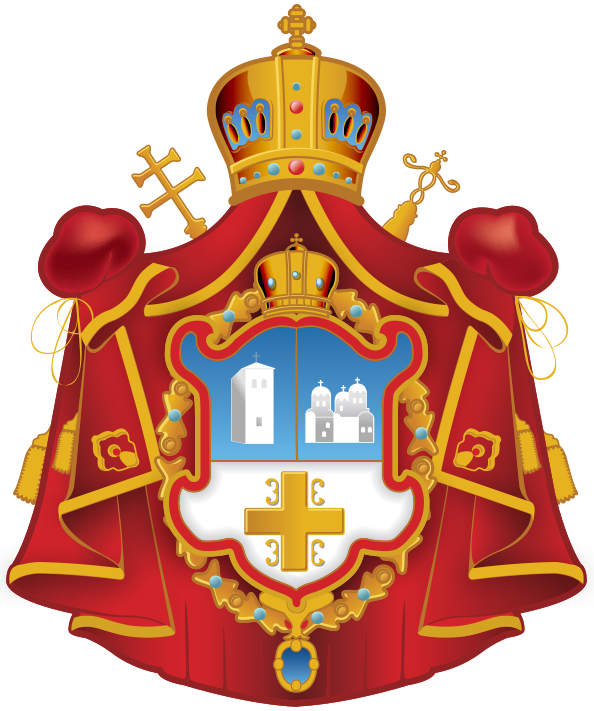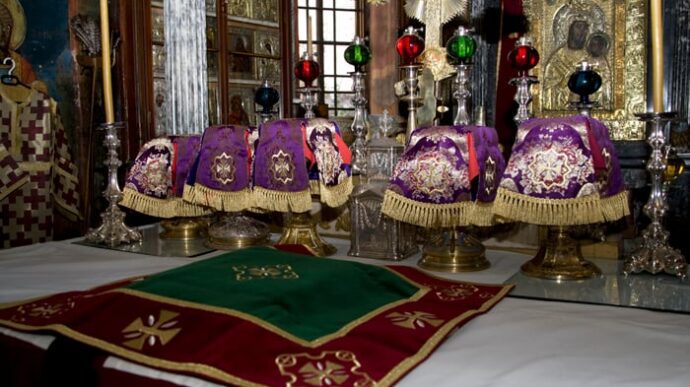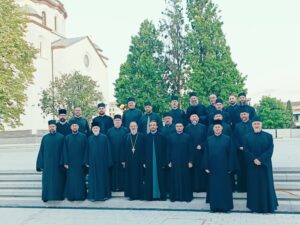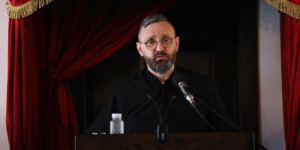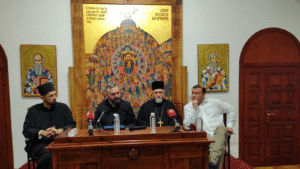The time of the Holy Forty Days represents a particularly sacred and elevated period within the liturgical year, during which we undergo spiritual renewal in preparation for the Feast of Feasts. The services in this holy period are entirely adapted to the season of repentance: the clergy wear vestments of dark colors, the church is “clothed” in somber tones, all serving as visible reminders of the penitential nature of this time. At the heart of Lenten worship is the Liturgy of the Pre-SanctifiedGifts, designed to intensify the active liturgical life, or rather, to facilitate frequent communion between two full Eucharistic Liturgies on Sundays.
The Liturgy of the Pre-Sanctified Gifts is celebrated only during the Holy Forty Days, specifically: on every Wednesday and Friday of the first six weeks of Great Lent; on the Thursday of the Fifth Week; and on Holy Monday, Holy Tuesday, and Holy Wednesday. It may also be served of Mondays,Tuesdays, and Thursdays of the second, third, fourth, fifth, and sixth weeks of Lent if those days coincide with the feast of a saint marked with the † symbol in the Typikon or a church patronal feast. It is essential to note that, according to the ancient Typikon of the Church, the full Eucharistic Liturgy is not permitted from Monday to Friday during the Holy Forty Days (except for the Feast of theAnnunciation), as the joy of the Eucharistic celebration is considered incompatible with the penitential character of Great Lent.
During Lenten services, the clergy wear dark-coloured vestments, and the church is adorned inpenitential tones, with purple being the predominant colour. The symbolism of this colour is deeply significant. If the spectrum of sunlight is represented in a circular form, where its ends meet, purple appears at the convergence of two opposites—red and blue.
Purple emerges from the fusion of these two contrasting colours—red and blue. It thus serves as a visual bridge, uniting the beginning and the end of the color spectrum of light. This colour is linked to Lenten worship, which calls to mind the passion and crucifixion of Christ, endured for our sake and for our salvation.
Christ Himself declared: “I am the Alpha and the Omega, the Beginning and the End, the First and the Last” (Rev. 22:13). The death of Christ on the Cross marked His rest from His salvific work in humannature, analogous to God’s rest on the seventh dayafter creating man, as described in the opening pages of the Old Testament. Purple is the seventh color in the spectrum, originating from red. Moreover, purple, which contains both red and blue, signifies the unique presence of both divine and human nature in Christ’s Person. For this reason, Christ is depicted in icons wearing red and bluegarments.
Purple also conveys the joyful message that through His death on the Cross, Christ has conquered death, just as the combination of the spectrum’s extreme colours leaves no room for blackness in the resultant circular form. Purple exudes the deepest spiritual significance.
The Liturgy of the Pre-Sanctified Gifts, its rite, origin, and necessity, cannot be fully understood without love for the Holy Mysteries and the practice of frequent communion. The theologian Aleksei Khomiakov rightly stated: “Christianity is understood only by those who understand the Liturgy.”
The Liturgy of the Pre–Sanctified Gifts is ancient and predates the anaphoras of St. Basil the Great andSt. John Chrysostom, as attested by Canon 49 of the Council of Laodicea. According to JohnZonaras, the great interpreter of the Holy Canons, Great Lent is a time of weeping and contrition before God, whereas the offering of the Liturgy is always a joyous occasion. How, then, can one rejoice and grieve at the same time?
During the Holy Forty Days, the Pre-Sanctified Liturgy is celebrated because the bloodless sacrificecannot be offered anew, but rather, the „already consecrated and completed Sacrament isdistributed.“ For this reason, the Holy Liturgy, as an expression of ultimate joy (a confirmation of the Resurrection and a foretaste of the Age to Come), is reserved for non-fasting days, while “in fasting, we are called to weep.”
The development of the Liturgy of the Pre-Sanctified Gifts was undoubtedly influenced by the fact that in the early centuries, the faithful regularly received Holy Communion, as attested by St. Basilthe Great, who stated that Christians of his time communed four times a week—on Wednesdays, Fridays, Saturdays, and Sundays. This explains the necessity of ensuring that the faithful couldreceive Communion even on days when the full Eucharistic Liturgy was not permitted, thus encouraging all members of the Church to partake more frequently in the Holy Mysteries and thereby strengthen themselves spiritually.
Although the Liturgy of the Pre-Sanctified Gifts may be considered an apostolic work, this is not because it was written by the Apostles themselves. In the early post-apostolic period, there was no fixed, written liturgical order. The Apostles did not transmit it orally in its present form, but it is still regarded as an apostolic institution in its general structure and main components.
The practice of Communion with the Pre-Sanctified Gifts has been preserved since apostolic times, as evidenced by the testimony of St. JustinMartyr, who wrote that deacons would bring the HolyMysteries of Christ’s Body and Blood to community members who were absent from the Eucharistic gathering for valid reasons, allowing them to receive Communion on the following or third day if they were adequately prepared.
In ancient times, another practice existed—reserving part of the Holy Gifts for daily self-Communion. St. Basil the Great reports that the Egyptian hermits, having no priest among them, kept the HolyGifts and communed from them. Similarly, in Alexandria and other cities of Egypt, believers also preserved the Holy Gifts for personal Communion.
As a creation of the apostolic Church, the Liturgy of the Pre-Sanctified Gifts is not attributedto asingle author. In the oldest manuscripts, its structure is recorded under the names of St. Jamesthe Apostle, St. Peter the Apostle, St. Mark the Evangelist, and St. Basil the Great. The rites of this Liturgy, which were observed in the Churches of Jerusalem, Antioch, and Alexandria, were later codifiedand edited by St. Basil the Great, who even composed some of its prayers. The Liturgy in this form was introduced in the Church of Constantinople, from where it spread throughout the Christian East.
The Role of St. Gregory the Dialogist
The attribution of the Liturgy of the Pre-Sanctified Gifts to St. Gregory the Dialogist (†604) emerged in later centuries (16th century) and was based on the deep reverence that the Orthodox East held for this Roman bishop and saint. St. Gregory lived in Constantinople for several years, where he encountered the structure of this Liturgy, which until then had not been recorded in writing. Inspired by its beauty and recognizing its significance for the spiritual life of Christians, St. Gregory recorded and structured the text of this Liturgy.
Greek synaxaria from the 9th century state that St. Gregory introduced the practice of celebrating the full Eucharistic Liturgy during the days of Great Lent among the Romans. Later, in the Prologue (under March 12th), this report was interpreted to mean that St. Gregory introduced the celebration of the Lenten Liturgy (the Pre-Sanctified Liturgy) into the Roman Church.
The Canonical Confirmation of the Liturgy
The universality of the Liturgy of the Pre-Sanctified Gifts is confirmed by Canon 52 of the Quinisext Council (Trullan Synod, 691 AD), which declared it universally obligatory:
“On all the days of the holy Forty Days, except on Saturdays, Sundays, and the holy day of the Annunciation, the Liturgy of the Pre-Sanctified Gifts shall be celebrated.”
This canon testifies to the liturgical and theological significance of the Liturgy of the Pre-Sanctified Gifts, ensuring its continued observance throughout the Christian world.
In the early Christian tradition, fasting primarily entailed abstaining from food until after the ninth hour (around 3 PM). To avoid breaking the fast, the faithful partook of Holy Communion only after the ninth hour. This is why the Liturgy of the Pre-Sanctified Gifts is an evening service with Communion, traditionally celebrated after the ninth hour. This form of fasting did not apply to Saturdays and Sundays, as it was prohibited by Canon 55 of the Quinisext Council (691 AD), except for Holy Saturday.
Regarding Eucharistic fasting, which requires complete abstinence from food and drink before receiving Holy Communion, it traditionally begins at midnight and lasts until the moment of Communion. If the Liturgy of the Pre-Sanctified Gifts is celebrated in the evening (as practiced in the Greek Church and increasingly in our local Church), both clergy and faithful are required to observe Eucharistic fasting until receiving Holy Communion, as affirmed by a decision of the Holy Assembly of Bishops of the Serbian Orthodox Church in 1995.
The Liturgy of the Pre-Sanctified Gifts echoes the voices of the early centuries, preserving the living tradition of the ancient Church. This tradition reminds us that believers cannot truly live in Christ unless they continually renew their connection with the Source of Life—through participation in the Holy Eucharist. As the Apostle Paul proclaims, “Christ is our life” (Col. 3:4). Those who refrain from Holy Communion deprive themselves of Christ, the wellspring of life, and place themselves outside of Him. Conversely, Orthodox Christians who approach Holy Communion with reverence and adequate preparation—as Christ Himself teaches—”abide in Him”.
Thus, Holy Communion must be a constant presence in the life of an Orthodox Christian. Our earthly life should be a journey toward union with God, as Christ must dwell in our hearts and souls. Those who seek this union with God in this life can hope to be with Him in eternity.
Written by: Catechist Branislav Ilić, Editor of „Kinonia“ Portal
